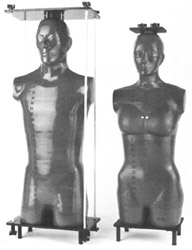ART Phantoms
for Radiation Treatment Planning
Because of variations of natural human skeletons, unknown calcium loss (approaching osteoporosis in some cases) and contamination by bleaches and other chemical agents in bone preparation, the ART "Superhuman" skeletons are designed and constructed to be both realistic and consistent. Molds for both the cortical bone and the medullary cavities were made using natural skeletons. Bone uniformity derived by this method acilitates positioning within the soft tissues, eliminating the need to make
compromises and modifications, as must be done with natural bones, to fit within fixed molds. Complete average-sized male and small-sized female phantoms may be assembled externally for film dosimetry or, internally, for TLD. Plates and tie rods for both assembly methods are included with every phantom.
Soft tissue materials are matched to muscle in specific gravity, mass density and absorption coefficients. Lungs are molded from syntactic foam, with a specific gravity of 0.30.
The ART phantom is transected horizontally in 1" slices and may be ordered undrilled for film dosimetry or drilled for TLD. The drilled phantoms are supplied with pins of appropriate material that may be replaced with optional TLD holders. Holes are available in 5 or 7 mm diameters on 1.5 x 1.5 cm or 3 x 3 cm grids.
Breasts can be ordered in various sizes. They can be drilled in the AP direction for dosimetry or sliced in frontal planes (drilled or undrilled) for film dosimetry. The male chest with breasts attached serves as a large female.
Nylon rods for internal assembly pass through registration holes, held by aluminum assembly plates, and clamped by knobs at the ends. The external assembly plates are larger, allowing tie rods to remain external to the larger phantom contours.
Solid pins are provided with drilled phantoms in appropriate quantity and materials. TLD holders are available in bone, tissue or lung-equivalent material and in 5 or 7mm O.D.
